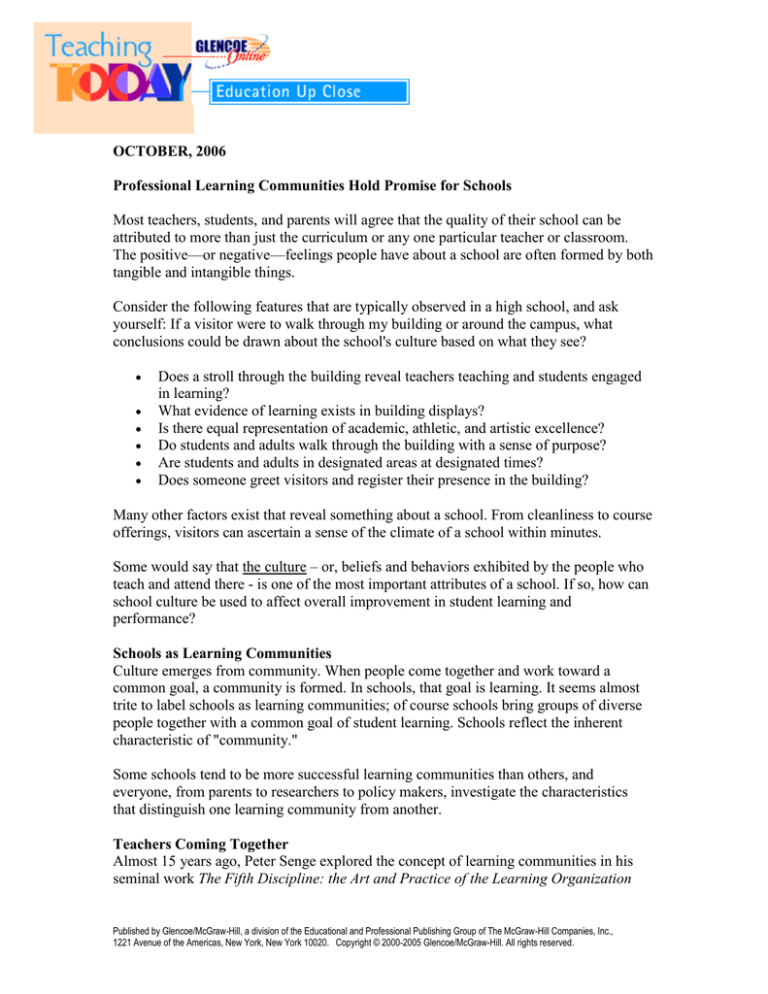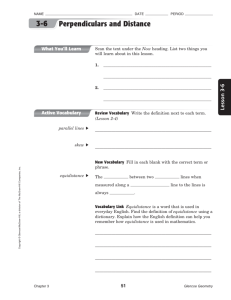
OCTOBER, 2006
Professional Learning Communities Hold Promise for Schools
Most teachers, students, and parents will agree that the quality of their school can be
attributed to more than just the curriculum or any one particular teacher or classroom.
The positive—or negative—feelings people have about a school are often formed by both
tangible and intangible things.
Consider the following features that are typically observed in a high school, and ask
yourself: If a visitor were to walk through my building or around the campus, what
conclusions could be drawn about the school's culture based on what they see?
Does a stroll through the building reveal teachers teaching and students engaged
in learning?
What evidence of learning exists in building displays?
Is there equal representation of academic, athletic, and artistic excellence?
Do students and adults walk through the building with a sense of purpose?
Are students and adults in designated areas at designated times?
Does someone greet visitors and register their presence in the building?
Many other factors exist that reveal something about a school. From cleanliness to course
offerings, visitors can ascertain a sense of the climate of a school within minutes.
Some would say that the culture – or, beliefs and behaviors exhibited by the people who
teach and attend there - is one of the most important attributes of a school. If so, how can
school culture be used to affect overall improvement in student learning and
performance?
Schools as Learning Communities
Culture emerges from community. When people come together and work toward a
common goal, a community is formed. In schools, that goal is learning. It seems almost
trite to label schools as learning communities; of course schools bring groups of diverse
people together with a common goal of student learning. Schools reflect the inherent
characteristic of "community."
Some schools tend to be more successful learning communities than others, and
everyone, from parents to researchers to policy makers, investigate the characteristics
that distinguish one learning community from another.
Teachers Coming Together
Almost 15 years ago, Peter Senge explored the concept of learning communities in his
seminal work The Fifth Discipline: the Art and Practice of the Learning Organization
Published by Glencoe/McGraw-Hill, a division of the Educational and Professional Publishing Group of The McGraw-Hill Companies, Inc.,
1221 Avenue of the Americas, New York, New York 10020. Copyright © 2000-2005 Glencoe/McGraw-Hill. All rights reserved.
(1990). He explained that while an assessment of school culture gives insight to the status
of the learning community as a whole, it may not reveal the level to which professional
learning communities (PLCs) are involved in the day-to-day formation of that culture.
Senge, an expert on how organizations can learn and grow, offered the concept of a
school community where organized groups of teachers regularly collaborate to seek and
share knowledge to benefit student learning.
While some might argue that teachers have always collaborated to benefit students,
Senge warned against the "fad cycle" that catches the attention of educators and proves to
be little more than experimentation in school improvement.
The goal of the professional learning community is not to provide a quick fix to
problems; it is to provide school reculturing.
A Cultural Shift
In Getting Started: Reculturing Schools to Become Professional Learning Communities,
authors Eaker, DuFour, and Dufour, emphasize the need to replace teacher isolation with
a sense of connectedness and purpose.
Teacher Characteristics in Professional Learning Communities
Have a clear sense of mission
Share a vision of the conditions they must create to achieve the mission
Work together in collaborative teams to determine the best practice to achieve the mission
Organize into groups, headed up by teacher-leaders
Focus on student learning
Are goal- and results-oriented
Collaborate with each other
Hold shared values and beliefs
Commit themselves to continuous improvement
See themselves as life-long learners
Professional Learning Communities in Action
One school that is incorporating the concept of professional learning communities is
Louisa County High School in Louisa, Virginia. The school has a staff of 120 teachers
who have formed 21 different learning communities, each with its own purpose to
improve student learning.
While one group may be devising and sharing games that teachers can use to improve
learning, another is researching ways to redirect physical education classes to promote
better health. Teachers meet monthly during a two-hour period previously dedicated to
mandated professional development activities.
If a visitor were to walk through the halls of Louisa County High School while the
professional learning communities are meeting, the most noticeable shift would be from
Published by Glencoe/McGraw-Hill, a division of the Educational and Professional Publishing Group of The McGraw-Hill Companies, Inc.,
1221 Avenue of the Americas, New York, New York 10020. Copyright © 2000-2005 Glencoe/McGraw-Hill. All rights reserved.
professional development activities that focused on how teachers teach to activities that
focus on how students learn.
Research Underscores the Power of the Concept
Dr. Shirley Hord provides an interpretation of the results of four complementary studies
conducted by the Center on Organization and Restructuring of Schools. The studies
involved three- and four-year longitudinal research using approaches that varied from
case study to collection of student data.
The results indicate that restructuring schools to "include decentralization, shared
decision-making, schools within schools, teacher teaming, and/or professional
communities of staff can improve student learning." Dr. Hord concludes that when
professional learning communities are in place, student dropout and absenteeism rates,
along with achievement gaps, decrease, and there are greater gains in core course
achievement.
Benefits of Professional Learning Communities
Decreased teacher isolation
Increased commitment to the mission
Fosters shared responsibility
Creates more powerful learning
Leads to a higher likelihood of fundamental, systemic change
Research and commentary indicate that reculturing schools, rather than buying into the
never-ending educational "fad cycle," holds promise for increased student achievement,
as well as improvements in attendance and graduation rates.
Change Requires Time
However, the notion of reculturing schools, coupled with the pressure of outcome-based
education and high-stakes testing, creates a seeming incongruence that leaders and
educators who move to PLCs must address.
Often, time is a luxury not afforded schools; parents and communities want schools that
"succeed" without the time it takes to reculture a school. Undoubtedly, if and as
additional evidence is found to support the idea of PLCs, more and more schools will turn
to professional learning communities to improve the deeply rooted problems that plague
education.
Resources
Eaker, Robert, Dufour, R. and Dufour, R. (2002). Getting Started: Reculturing Schools to
Become Professional Learning Communities. National Educational Service.
Hord, Shirley M. (1997). Outcomes of Professional Learning Communities for Students
and Staffs. Southwest Educational Development Laboratory. Texas.
Published by Glencoe/McGraw-Hill, a division of the Educational and Professional Publishing Group of The McGraw-Hill Companies, Inc.,
1221 Avenue of the Americas, New York, New York 10020. Copyright © 2000-2005 Glencoe/McGraw-Hill. All rights reserved.
Published by Glencoe/McGraw-Hill, a division of the Educational and Professional Publishing Group of The McGraw-Hill Companies, Inc.,
1221 Avenue of the Americas, New York, New York 10020. Copyright © 2000-2005 Glencoe/McGraw-Hill. All rights reserved.




